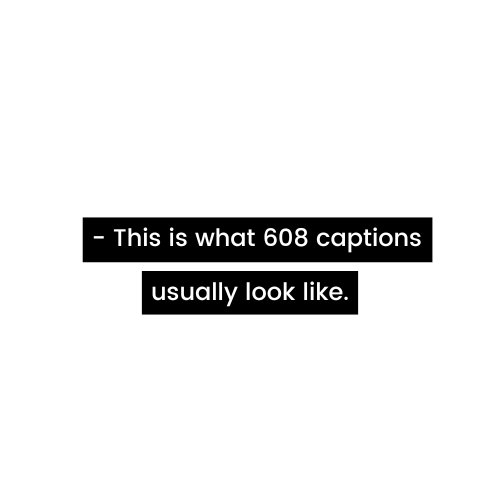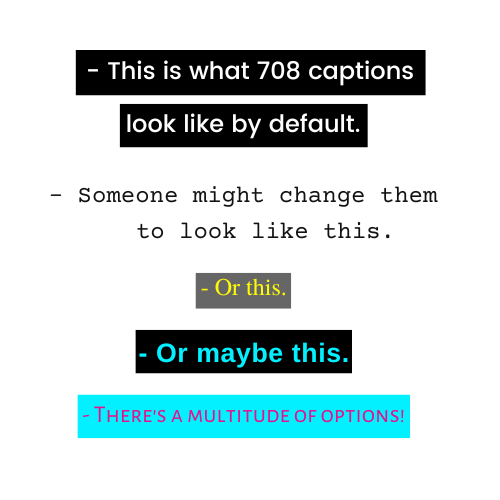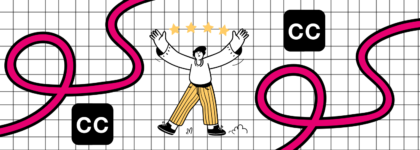What is 608 and 708 Closed Captioning?
Updated: November 3, 2023
FCC Requirements for Closed Captioning of Online Video [Free eBook]
Closed captions are a vital accessibility feature for people who are deaf or hard of hearing. There are two main standards for encryption and decryption of closed captioning data based on Federal Communications Commission (FCC) regulations: CEA-608 and CTA-708. CEA-608 is the older standard and is used for analog television, while CEA-708 is the newer standard and is used for digital television.
While 708 is the newer standard, 608 is still widely used because it is compatible with digital televisions. Additionally, some devices, such as streaming players, may only support 608 closed captions.
In this blog post, we will discuss the differences between 608 and 708 closed captions, and explain why both standards are still important.
A Tale of Two Caption Standards
In 2009, the DTV Delay Act was passed in the United States, officially replacing analog television with digital television. At the time, it was expected that 608 captions would transition to 708 captions, so 708 closed captions subsequently became the preferable standard by the FCC for all digital television.
In an effort to make the transition from 608 to 708 closed captioning smoother, digital television maintained the ability to support 608 captions. And while this support was intended for transitional purposes, 608 closed captions continue to be widely used in digital televisions today.
What are 608 Closed Captions?
608 closed captions (also known as CEA-608, EIA-608, or Line 21 captions) were the standard for analog television. 608 captions are compatible with digital television via picture user data, which was meant to make the transition from analog easier. However, 608 captions do not support any of the appearance or customization options offered by 708 captions.
Appearance
608 captions are most recognizable for their stereotypical closed caption appearance: white text over a black box.

608 closed captions usually have the classic appearance as depicted in this example.
Transmission
608 closed captions are transmitted via Line 21 captioning data. This is a transmission data stream that carries closed captions as well as V-Chip data (which provides the small TV rating you see in the top corner of the screen based on violence, language, and more.)
Line 21 itself is not viewable on television or videos, but the hidden data is decoded to make captions appear overlayed on a video stream. It has two fields – usually, English captions are transmitted in the first field and Spanish captions are transmitted in the second field.
Languages
608 closed captions only support the display of regular Latin language characters in languages such as English, Spanish, and French. Extended character sets have also been added to 608 over the years to better support Western languages. The two fields available in Line 21 allow for only two language options at a time.
Formatting & Style Options
The formatting options are limited for 608 closed captions, but have basic support for styles such as placement, italics, and capitalization. These elements must be implemented on the captioner’s end, as the user does not have control over the customization options for 608 captions.
The Closed Captioning Terms & Laws You Need to Know 📖
What are 708 Closed Captions?
708 closed captions (also known as CEA-708/EIA-708/CTA-708 captions) are the newer standard for digital television. 708 captions are not compatible with analog television.
Appearance
708 closed captions are customizable to viewers. Because of this, 708 captions are considered more accessible to individual viewers with unique requirements & preferences – for example, a person who is colorblind may prefer to change the text and background colors to create higher contrast.
The only appearance-related quality of 708 captioning that a user cannot control is whether the captions are roll-up or pop-on style, because of the fact that the two methods must be formatted differently.

Note: Above is an example of potential options for 708 closed captions. Exact options (colors, fonts, sizing) may vary across televisions.
Transmission
708 closed captions are transmitted via MPEG-2 video streams in MPEG user data, which carries information such as the aspect ratio in addition to 708 captioning data. 708-supported digital encoders have higher processing power and bandwidth, allowing for greater customization of closed captions on the user’s end.
Languages
708 closed captions allow for broader character recognition based on Unicode, which supports a wider array of languages beyond 608’s Latin-based characters, such as Korean, Japanese, and more.
Furthermore, 708 closed caption transmission allows for multiple tracks to be included in one program, extending the multilingual capacity of closed captioning and making programming more accessible for a global audience.
Formatting & Style Options
Greater functionality exists for color and font customization in 708 closed captions, which can be controlled by the user. These settings are often adjustable via the channel box in cable or satellite TV.
Styles such as placement, italics, and case are supported, and the closed captioner will implement best style practices based on the program, as with 608 captions, but the viewer may make further customizations to font, color, backgrounds, etc. in order to best meet their personal needs.
What kind of customizations can viewers choose from in 708 captions? 8 font options, 3 text sizes, 64 text colors, 64 background colors, background opacity, and dropshadowed (or edged) text!
608 vs. 708 Captions: Which is Better?
608 = old, 708 = new. So that means 708 is better, right? Unfortunately, the answer isn’t that simple.
It’s true that 708 captions are an improved captioning standard, with more options for appearance, placement, and languages. And it’s true that 708 captions are recommended by the FCC as the best closed captioning standard for digital television.
But despite the advancements in technology, 608 closed captions remain the primary format for many transmissions in the United States. In fact, most existing industry-standard caption data formats, such as SCC files, only store CEA-608 caption data by design. These files are “up-converted” to include 708 data where appropriate when they are run through a decoder or used to embed caption tracks into a master video file.
608 captions may be “old-school”, but they remain relevant for digital video today because of their flexibility and ability to conform to modern specs; 608 data can be used as a substitute for 708 data, but 708 data cannot be used in analog systems that are only set up to receive 608. Many broadcast networks still require files with 608 data for compatibility with older devices, rather than assuming all audiences have upgraded to digital television.
| 608 Closed Captions | 708 Closed Captions |
| Standard for analog television | Standard for digital television |
| Compatible with digital | Incompatible with analog |
| Line 21 transmission | Transmission via MPEG-2 data streams |
| White text over a black box | Customizable, with options including 8 fonts, 3 text sizes, 64 text colors, 64 background colors, background opacity, and dropshadowed (or edged) text |
| Supports two languages at a time | Supports multiple languages at a time |
| Language options limited to regular Latin characters, with some support for extended characters | Language options are extensive and based on Unicode |
| Caption positioning implemented by captioner; cannot be adjusted by viewer | Caption positioning implemented by captioner; can be adjusted by viewer |
The Future of 608 Captions & 708 Captions
The last remaining National Television Standards Committee (NTSC) analog transmissions were switched off in July of 2021, over 12 years after the DTV Delay Act was passed, but as for when all closed captions will completely move to 708 closed captioning standards remains to be seen.
Between CEA-608’s flexibility and CTA-708’s customizations, both continue to stay relevant in the digital age of broadcast television. And as long as 608 and 708 are supported, 3Play Media can help you meet either, or both, of the 608 and 708 closed captioning standards while simultaneously remaining compliant with FCC regulations.
This blog was originally published in October 2014 as Closed Captioning for Broadcast Television: What’s the Difference Between 708 Captions and 608 (Line 21) Captions? It was updated on September 15, 2021 by Kelly Mahoney. This article has since been updated again in combination with information from 608 and 708 Closed Captions: A Primer (originally published by Captionmax) for accuracy, clarity, and freshness.
This blog post is written for educational and general information purposes only and does not constitute specific legal advice. This blog should not be used as a substitute for competent legal advice from a licensed professional attorney in your state.






